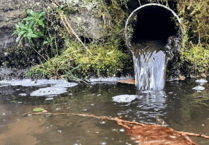FOR 30 years or more, people living on the Waun above Aberystwyth have enjoyed drawing breath, walking, running, playing sports and taking dogs for walks on their blustery and semi-wild stretch of hilltop known as Erw Goch Field.
It’s important to stress the matter of ownership. Because as soon as we start talking about anything being “council-owned” - whether land, or town halls, refuse-trucks or municipal flower-beds - we not only mislead ourselves but, particularly at moments of dissent, put ourselves at a psychological disadvantage by misguidedly deferring to whatever public body is airily claiming ownership, and by doing so establishing for itself a position of advantage in the event of a clash with the true owners - the public.
Erw Goch Field is thus owned by us all and has been used by a good few of us for a rich variety of recreational purposes for as long as anyone can remember. It is long established as a classic example of a vital semi-urban green lung, the kind of priceless asset that must never be surrendered to a destructive invasion by bulldozers, roads and concrete.
Which is exactly what lies in store for this precious piece of landscape, with its sea views and vibrant wildlife, if the local population’s efforts to kill off the threat of housing development, and get it officially registered as a village green, fails.
For this land to be obliterated by 77 houses, as proposed, would be a betrayal of the people who have for so long depended on it as an integral part of their day-to-day living. Laying down a mass of concrete, bricks, drains and tarmac would fly in the face of our obligation to take with the utmost seriousness the current biodiversity crisis. This field is wildlife-rich, and could be made more so with the carefully planned planting of more trees and hedges. On a walk there recently, I breathed in rushes of clean sea air and saw blackbirds, pied wagtails, dunnocks, chiffchaffs and blue-tits. This is their land, too.
Administratively, Ceredigion council appears on dodgy ground. It is the registration authority for village greens, and simultaneously the planning authority. Every appearance is of a clear and insurmountable conflict of interest, a built-in inability to be impartial.
The council says it has “considered its position regarding any potential conflicts of interests, and ensured that appropriate arrangements are in place to ensure separation of roles.” At best, that sounds like wishful thinking, at worst, eyewash.
Why Wales must have its own electricity grid
THIS COLUMN has for ages been calling for taxpayer-owned renewable energy-generation - probably principally wind-turbines. Allowing for set-up, maintenance and distribution costs, such a system could use local or regional grids to supply consumers with electricity free at the point of delivery.
The idea is that renewable energy-provision could be regarded in the same way as a range of other taxpayer-funded public services, such as health, education and roads, which are all provided free at the point of delivery.
Plans recently announced by the Welsh government to set up a new publicly-owned renewable energy company are a significant and very welcome step towards this goal. But the proposals are insufficiently radical.
Initially, the new company will focus on developing windfarms on publicly-owned woodland, and the scheme, very belatedly, will ensure that financial gains are not syphoned off abroad. Currently, the biggest windfarms in Wales are foreign-owned, often by overseas governments, including Sweden and France.
Certainly, the project is a UK first and will do its bit to tackle the climate crisis. But, addressing the Senedd, climate change minister Julie James was unexcitingly vague, suggesting little more than that energy profits could be used for home-insulation for people living near the new windfarms.
The vision needs to be considerably widened. Will energy from our publicly-funded and publicly-owned windfarms simply be fed into the National Grid, with the power entering the general energy pot and fed back to Welsh households at the going price, which in the case of rural counties, such as Ceredigion, is consistently higher than elsewhere in Britain?
What precisely will happen to the potentially huge earnings coming the way of the Welsh public purse? It’s a fair bet that the citizens of Wales would be more interested in electricity free at the point of delivery than in provision of home-insulation, important as that is.
Let’s look seriously, too, at local and regional electricity grids. Why export Wales-generated renewable energy, only for it to be sent back, exclusively via the National Grid, volumes of electricity meanwhile being diminished through moving it about?
Ceredigion organic vegetable-growers used to look askance at the potty system insisted on by supermarkets which saw carrots grown here sent to East Anglia to be washed, before being lorried back to shops in west Wales. The growers rebelled, deserted the supermarkets and started selling direct to customers through local markets and shops. They never looked back. Let’s make it the same for home-grown electricity.


.jpeg?width=209&height=140&crop=209:145,smart&quality=75)


Comments
This article has no comments yet. Be the first to leave a comment.